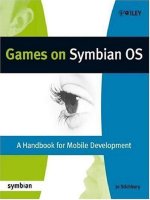CRC press network design for IP convergence feb 2009 ISBN 1420067508 pdf
Bạn đang xem bản rút gọn của tài liệu. Xem và tải ngay bản đầy đủ của tài liệu tại đây (10.95 MB, 308 trang )
Network Design
for IP Convergence
OTHER TELECOMMUNICATIONS BOOKS FROM AUERBACH
Active and Programmable Networks
for Adaptive Architectures and Services
Syed Asad Hussain
ISBN: 0-8493-8214-9
Ad Hoc Mobile Wireless Networks:
Principles, Protocols and Applications
Subir Kumar Sarkar, T.G. Basavaraju,
and C. Puttamadappa
ISBN: 1-4200-6221-2
Introduction to Mobile Communications:
Technology, Services, Markets
Tony Wakefield, Dave McNally, David Bowler,
and Alan Mayne
ISBN: 1-4200-4653-5
Millimeter Wave Technology in Wireless
PAN, LAN, and MAN
Shao-Qiu Xiao, Ming-Tuo Zhou, and Yan Zhang
ISBN: 0-8493-8227-0
Comprehensive Glossary of Telecom
Abbreviations and Acronyms
Ali Akbar Arabi
ISBN: 1-4200-5866-5
Mobile WiMAX: Toward Broadband
Wireless Metropolitan Area Networks
Yan Zhang and Hsiao-Hwa Chen
ISBN: 0-8493-2624-9
Contemporary Coding Techniques and
Applications for Mobile Communications
Onur Osman and Osman Nuri Ucan
ISBN: 1-4200-5461-9
Optical Wireless Communications:
IR for Wireless Connectivity
Roberto Ramirez-Iniguez, Sevia M. Idrus,
and Ziran Sun
ISBN: 0-8493-7209-7
Context-Aware Pervasive Systems:
Architectures for a New Breed of
Applications
Seng Loke
ISBN: 0-8493-7255-0
Performance Optimization of Digital
Communications Systems
Vladimir Mitlin
ISBN: 0-8493-6896-0
Data-driven Block Ciphers for Fast
Telecommunication Systems
Nikolai Moldovyan and Alexander A. Moldovyan
ISBN: 1-4200-5411-2
Physical Principles of Wireless
Communications
Victor L. Granatstein
ISBN: 0-8493-3259-1
Distributed Antenna Systems:
Open Architecture for Future Wireless
Communications
Honglin Hu, Yan Zhang, and Jijun Luo
ISBN: 1-4200-4288-2
Principles of Mobile Computing
and Communications
Mazliza Othman
ISBN: 1-4200-6158-5
Encyclopedia of Wireless and Mobile
Communications
Borko Furht
ISBN: 1-4200-4326-9
Resource, Mobility, and Security
Management in Wireless Networks
and Mobile Communications
Yan Zhang, Honglin Hu, and Masayuki Fujise
ISBN: 0-8493-8036-7
Handbook of Mobile Broadcasting:
DVB-H, DMB, ISDB-T, AND MEDIAFLO
Borko Furht and Syed A. Ahson
ISBN: 1-4200-5386-8
Security in Wireless Mesh Networks
Yan Zhang, Jun Zheng, and Honglin Hu
ISBN: 0-8493-8250-5
The Handbook of Mobile Middleware
Paolo Bellavista and Antonio Corradi
ISBN: 0-8493-3833-6
Wireless Ad Hoc Networking:
Personal-Area, Local-Area,
and the Sensory-Area Networks
Shih-Lin Wu and Yu-Chee Tseng
ISBN: 0-8493-9254-3
The Internet of Things: From RFID
to the Next-Generation Pervasive
Networked Systems
Lu Yan, Yan Zhang, Laurence T. Yang,
and Huansheng Ning
ISBN: 1-4200-5281-0
Wireless Mesh Networking:
Architectures, Protocols
and Standards
Yan Zhang, Jijun Luo, and Honglin Hu
ISBN: 0-8493-7399-9
AUERBACH PUBLICATIONS
www.auerbach-publications.com
To Order Call: 1-800-272-7737 • Fax: 1-800-374-3401
E-mail:
Network Design
for IP Convergence
Yezid Donoso
Auerbach Publications
Taylor & Francis Group
6000 Broken Sound Parkway NW, Suite 300
Boca Raton, FL 33487‑2742
© 2009 by Taylor & Francis Group, LLC
Auerbach is an imprint of Taylor & Francis Group, an Informa business
No claim to original U.S. Government works
Printed in the United States of America on acid‑free paper
10 9 8 7 6 5 4 3 2 1
International Standard Book Number‑13: 978‑1‑4200‑6750‑7 (Hardcover)
This book contains information obtained from authentic and highly regarded sources. Reasonable
efforts have been made to publish reliable data and information, but the author and publisher can‑
not assume responsibility for the validity of all materials or the consequences of their use. The
authors and publishers have attempted to trace the copyright holders of all material reproduced
in this publication and apologize to copyright holders if permission to publish in this form has not
been obtained. If any copyright material has not been acknowledged please write and let us know so
we may rectify in any future reprint.
Except as permitted under U.S. Copyright Law, no part of this book may be reprinted, reproduced,
transmitted, or utilized in any form by any electronic, mechanical, or other means, now known or
hereafter invented, including photocopying, microfilming, and recording, or in any information
storage or retrieval system, without written permission from the publishers.
For permission to photocopy or use material electronically from this work, please access www.copy‑
right.com ( or contact the Copyright Clearance Center, Inc. (CCC), 222
Rosewood Drive, Danvers, MA 01923, 978‑750‑8400. CCC is a not‑for‑profit organization that pro‑
vides licenses and registration for a variety of users. For organizations that have been granted a
photocopy license by the CCC, a separate system of payment has been arranged.
Trademark Notice: Product or corporate names may be trademarks or registered trademarks, and
are used only for identification and explanation without intent to infringe.
Library of Congress Cataloging‑in‑Publication Data
Donoso, Yezid.
Network design for IP convergence / Yezid Donoso.
p. cm.
Includes bibliographical references and index.
ISBN 978‑1‑4200‑6750‑7 (alk. paper)
1. Computer network architectures. 2. Convergence (Telecommunication) 3.
TCP/IP (Computer network protocol) I. Donoso, Yezid. II. Title.
TK5105.52.D66 2009
004.6’5‑‑dc22
Visit the Taylor & Francis Web site at
and the Auerbach Web site at
rbach‑publications.com
2008043273
To my wife, Adriana—
for her love and for our future together.
To my children, Andres Felipe, Daniella, and Marianna—
a gift of God to my life.
Contents
Preface.............................................................................................................xi
About the Author......................................................................................... xiii
List of Translations........................................................................................ xv
1
Computer Network Concepts..................................................................1
1.1 Digital versus Analog Transmission....................................................1
1.2 Computer Networks According to Size..............................................7
1.2.1 Personal Area Networks (PANs)............................................7
1.2.2 Local Area Networks (LANs)................................................7
1.2.3 Metropolitan Area Networks (MANs)...................................8
1.2.4 Wide Area Networks (WANs).............................................10
1.3 Network Architectures and Technologies.........................................11
1.3.1 OSI......................................................................................11
1.3.2 PAN....................................................................................13
1.3.2.1 Bluetooth.............................................................13
1.3.3 LAN....................................................................................15
1.3.3.1 Ethernet...............................................................15
1.3.3.2 WiFi....................................................................15
1.3.4 MAN/WAN........................................................................16
1.3.4.1 TDM (T1, T3, E1, E3, SONET, SDH)...............16
1.3.4.2 xDSL...................................................................18
1.3.4.3 WDM (DWDM)................................................19
1.3.4.4 PPP/HDLC.........................................................20
1.3.4.5 Frame Relay.........................................................20
1.3.4.6 ATM...................................................................21
1.3.4.7 WiMAX..............................................................22
1.3.4.8 GMPLS...............................................................23
1.3.5 TCP/IP................................................................................24
1.4 Network Functions...........................................................................25
1.4.1 Encapsulation......................................................................25
vii
viii Contents
1.5
1.4.2 Switching.............................................................................26
1.4.3 Routing...............................................................................35
1.4.4 Multiplexing........................................................................41
Network Equipments.......................................................................43
1.5.1 Hub.....................................................................................43
1.5.2 Access Point.........................................................................45
1.5.3 Switch..................................................................................47
1.5.4 Bridge..................................................................................61
1.5.5 Router.................................................................................63
1.5.6 Multiplexer......................................................................... 64
2
LAN Network Design............................................................................67
2.1 Ethernet Solution.............................................................................67
2.1.1 Edge Connectivity.............................................................. 77
2.1.2 Core Connectivity...............................................................83
2.2 WiFi Solution...................................................................................85
2.3 LAN Solution with IP......................................................................88
2.4 VLAN Design and LAN Routing with IP.......................................94
2.5 LAN-MAN Connection................................................................113
3
MAN/WAN Network Design..............................................................125
3.1 Last-Mile Solution..........................................................................125
3.1.1 LAN Extended..................................................................126
3.1.2 Clear Channel...................................................................128
3.1.3 ADSL................................................................................134
3.1.4 Frame Relay.......................................................................142
3.1.5 WiMAX............................................................................148
3.1.6 Ethernet Access................................................................. 153
3.2 MAN/WAN Core Solution............................................................154
3.2.1 ATM (SONET/SDH).......................................................156
3.2.1.1 Digital Signal Synchronization..........................156
3.2.1.2 Basic SONET Signal......................................... 157
3.2.1.3 SONET Characteristics..................................... 157
3.2.1.4 SONET Layers.................................................. 158
3.2.1.5 Signals Hierarchy.............................................. 159
3.2.1.6 Physical Elements of SONET............................ 159
3.2.1.7 Network Topologies..........................................160
3.2.1.8 SONET Benefits...............................................160
3.2.1.9 SONET Standards............................................ 161
3.2.1.10 Synchronous Digital Hierarchy (SDH).............. 161
3.2.1.11 Elements of Synchronous Transmission.............165
3.2.1.12 Types of Connections........................................166
3.2.1.13 Types of Network Elements...............................166
Contents ix
3.3
3.4
3.2.1.14 Configuration of an SDH Network...................167
3.2.2 Metro Ethernet..................................................................171
3.2.3 DWDM............................................................................171
GMPLS..........................................................................................175
3.3.1 MPLS Packet Fields...........................................................177
3.3.1.1 Characteristics...................................................177
3.3.1.2 Components......................................................177
3.3.1.3 Operation..........................................................179
MAN/WAN Solution with IP........................................................180
4
Quality of Service................................................................................185
4.1 LAN Solution.................................................................................189
4.1.1 VLAN Priority..................................................................190
4.1.2 IEEE 802.1p......................................................................195
4.2 MAN/WAN Solution.....................................................................195
4.2.1 QoS in Frame Relay..........................................................196
4.2.2 QoS in ATM.....................................................................201
4.2.3 QoS in ADSL....................................................................205
4.2.4 QoS in MPLS................................................................... 206
4.2.4.1 CR-LDP........................................................... 208
4.2.4.2 RSVP-TE........................................................... 214
4.3 QoS in IP (DiffServ)...................................................................... 218
4.3.1 PHB..................................................................................221
4.3.2 Classifiers...........................................................................221
4.3.3 Traffic Conditioners..........................................................221
4.3.4 Bandwidth Brokers (BBs)................................................. 222
4.4 QoS in Layer 4 (TCP/UDP Port).................................................. 222
4.5 QoS in Layer 7 (Application)..........................................................227
4.6 Network Design with Bandwidth Manager....................................229
5
Computer Network Applications........................................................235
5.1 Not Real-Time Applications...........................................................235
5.1.1 HTTP...............................................................................236
5.1.2 FTP...................................................................................238
5.1.3 SMTP and (POP3/IMAP)................................................239
5.2 Real-Time Applications..................................................................241
5.2.1 VoIP..................................................................................241
5.2.1.1 IP-PBX..............................................................242
5.2.1.2 Cellular IP.........................................................250
5.2.2 IPTV................................................................................ 264
5.2.3 Videoconference............................................................... 266
5.2.4 Video Streaming............................................................... 268
5.3 Introduction to NGN and IMS Networks..................................... 268
x Contents
References....................................................................................................273
Index............................................................................................................277
Preface
The need to integrate services under a single network infrastructure in the Internet
is increasingly evident. The foregoing is what has been defined as convergence of
services, which has been widely explained for many years. However, in practice,
implementation of convergence has not been easy due to multiple factors, among
them the integration of different layer 1 and layer 2 platforms and the integration
of different ways of implementing the concepts of quality of service (QoS) under
these technological platforms.
It is precisely for the abovementioned reasons that this book was written; it
aims to provide readers with a comprehensive, global vision of service convergence
and especially of IP networks. We say this vision is “global” because it addresses
different layers of the reference models and different technological platforms in
order to integrate them as occurs in the real world of carrier networks. This book
is comprehensive because it explains designs, equipment, addressing, QoS policies,
and integration of services, among other subjects, to understand why a specific layer
or a technology may cause a critical service to not operate correctly.
This book addresses the appropriate designs for traditional and critical services
in LAN networks and in carrier networks, whether MAN or WAN. Once the
appropriate design for these networks under the existing different technological
platforms has been explained in detail, we also explain under the multilayer scheme
the concepts and applicability of the QoS parameters. Finally, once infrastructure
has been covered, we explain integration of the services, in “not real time” and “real
time,” to show that they can coexist under the same IP network.
The book’s structure is as follows:
Chapter 1—In Chapter 1 we explain some basic concepts of networks, the layer
in which some of the most representative technologies are operating, and operation
of some basic network equipment.
Chapter 2—This chapter concentrates on the specification of a design that’s
appropriate for a LAN network in which converged services are desired.
Chapter 3—Chapter 3 specifies a design that is appropriate both in the backbone and in the last mile in MAN and WAN carrier networks, in order to appropriately support service convergence.
xi
xii Preface
Chapter 4—Chapter 4 introduces the different QoS schemes under different
platforms and explains how to specify them for critical services in order to successfully execute service convergence.
Chapter 5—Finally, Chapter 5 discusses service convergence for not real-time
and real-time applications, and how these services integrate to the carrier LAN and
MAN or WAN network designs.
About the Author
Yezid Donoso, PhD, is currently a professor of computer networks in the
Computing and System Engineering Department at the Universidad de los Andes
in Bogotá, Colombia. He is a consultant in computer network and optimization for
Colombian industries. He has a degree in system and computer engineering from
the Universidad del Norte (Barranquilla, Colombia, 1996), an MSc degree in system
and computer engineering from the Universidad de los Andes (Bogotá, Colombia,
1998), a DEA in information technology from Girona University (Girona, Spain,
2002), and a PhD (cum laude) in information technology from Girona University
(Girona, Spain, 2005). He is a senior member of IEEE and a distinguished visiting professor. His biography is published in the following books: Who’s Who in
the World, 2006 edition; Who’s Who in Science and Engineering by Marquis Who’s
Who in the World; and 2000 Outstanding Intellectuals of the 21st Century by the
International Biographical Centre, Cambridge, England, 2006. He received the title
Distinguished Professor from the Universidad del Norte (Colombia, October 2004)
and a National Award of Operations from the Colombian Society of Operations
Research (2004). He is the co-author of the book Multi-Objective Optimization in
Computer Networks Using Metaheuristics (2007). He can be reached via e-mail at
xiii
List of Translations
Spanish
English
Número de canales de enlaces de
VoIP
Number of VoIP channels
Número de canales de abonados de
VoIP
Number of VoIP trunking
Calidad de servicio IP
IP quality of service
Extensión
Extension
Plan numeración Pal
Main numeration plan
Plan de numeración público
Public numeration plan
Plan de numeración privado
Private numeration plan
Plan de numeración público
restringido
Restricted public numeration plan
Añadir
Add
Borrar
Delete
Modificar
Update
Cancelar
Cancel
Placa IP
IP values
Placas
Values
Direcciones IP para PPP
IP address for PPP
CPU principal
Main CPU
Acceso internet
Internet access
VoIP (esclavo)
VoIP (slave)
xv
xvi List of Translations
Spanish
English
Dirección de router por defecto
Default gateway address
Máscara subred IP
IP subset mask
Ayuda
Help
Direccion IP
IP address
Nombre gateway VoIP
VoIP gateway name
Configuración IP de Windows 2000
Windows 2000 IP configuration
Nombre del host
Host name
Sufijo DNS principal
Main DNS suffix
Tipo de nodo
Node type
Enrutamiento de IP habilitado
IP routing active
Proxy de wins habilitado
Wins proxy active
Ethernet adaptador conexión de área
local
Ethernet adapter local area connection
Descripción
Description
Dirección física
Hardware address
Mascara de subred
Subnet mask
Puerta de enlace predeterminada
Default gateway
Servidores DNS
DNS servers
Fichero de datos
Date file
Cliente
Client
Tabla ARS
ARS table
Inicio
Start
Herramientas
Tools
Proveedor
Provider
Instalación típica
Typical installation
Modificación tipica
Typical update
Numeración
Numeration
List of Translations xvii
Spanish
English
Números de instalación
Installation numbers
Configuración por defecto
Default configuration
Plan de numeración
Numeration plan
Códigos de servicio
Service codes
Tabla modif. números DDI
Update table DDI numbers
Tabla prefijos fraccionamiento
Fraction prefix table
Fin de marcación
Dial end
Selección automática de rutas
Automatic route selection
Tabla ARS
ARS table
Lista de grupos
Group list
Tabla de horas
Hour table
Grupos del día
Day groups
Operadores/destinos
Operators/destination
Códigos de autorización
Authorization codes
Tono/pausa
Tone/pause
Varios ARS
ARS various
Conversion PTN
PTN conversion
Chapter 1
Computer Network
Concepts
This book addresses network design and convergence of IP services. In this first
chapter, we present a basic analysis of computer network fundamentals. For more
in-depth information on these topics, we recommend reading [KUR07], among
others.
In this first chapter we present fundamentals on the main difference between
digital transmission and analog transmission, network classification according to
size, some network architectures and technologies, and basic functions that take
place in computer networks; last, we explain the operation of the different devices
with which network design will subsequently take place.
1.1 Digital versus Analog Transmission
When transmitting over a computer network one can identify two concepts. The
first concept is the nature of the data, and the second is the nature of the signal over
which such data will be transmitted.
The nature of data can be analog or digital.
An example of digital data is a text file forwarded through a PC. The characters
of this file are coded, for example, through the ASCII code, and converted to binary
values (1s and 0s) called bits, which illustrate said ASCII character (Figure 1.1). The
same would happen for a binary file (.doc, .xls, .jpg, etc.), in which binary value
illustrates part of the information found in the file, whether through a text processor, spreadsheet, or images.
1
2 Network Design for IP Convergence
Character
A
ASCII HEX 41
ASCII BIN 01000001
Figure 1.1 Digital data.
An example of analog data is transmitted voice or video. In voice the information is analog; here we produce sound, where its tones are represented as continuous
waves over time and do not display discrete specific values, as happens with digital
data. Figure 1.2 shows the transmission of analog data of a person using the phone.
The nature of the signal can also be analog or digital.
An example of digital signals is transmission of information from a PC to the
computer network (Figure 1.3). Here, the PC produces digital information (consisting of a series of 1s and 0s called bits) that will be transmitted over the data network also as 1s and 0s. This does not mean that a direct relationship exists between
the physical way in which the PC transmits a 1 and how the computer network
understands a 1; in other words, there are different kinds of coding schemes to
Figure 1.2 Analog data.
Computer Network Concepts 3
*
1 0 1 0 1 0 1
*
1 0 1 0 1 0 1
Figure 1.3 Digital signals.
represent bits and these can vary from PC to network and even between different
network technologies. For example, in transmissions over copper wires there are
network technologies that understand a 1 as a high-voltage (+5 V) level and other
technologies may understand the 1 as –5 V. It is important, therefore, to correctly
interconnect the physical transmission of these technologies so that when a transmitting device forwards a bit as 1 and +5 V, the receiver understands that +5 V
means a 1 at the bit level.
An analog signal is data or information transmitted as a continuous signal
regardless of the nature of the data. Figure 1.4 shows that a PC is transmitting
digital data over analog signals.
We have seen that to transmit information one can use digital or analog signals. The question now is how to represent an analog signal and how to represent
a digital signal.
1
0.8
0.6
0.4
0.2
0
*
*
–0.2
–0.4
–0.6
–0.8
–1
1
0
1
0
1
0
1
Figure 1.4 Analog signals.
0
0.5
1
1.5
2
2.5
3
3.5
4
4 Network Design for IP Convergence
1.5
1
s(t)
0.5
0
–0.5
–1
–1.5
0
0.2
0.4
0.6
0.8
1
t
1.2
1.4
1.6
1.8
2
Figure 1.5 Sin function.
The main characteristic of analog signals is their continuous form with small
changes in the value of the function. Analog signals can be represented through
Fourier series, and in this case every analog transmission could be represented by a
combination of sinusoidal or cosinusoidal functions. In this case we could say that
we have a function that can be described in the following way:
s(t ) = sin(2πft )
Here we can say that the value of the signal in the time (t) domain depends on the
frequency (f ) being used; we would thus be illustrating an analog signal, which is
continuous in time. To show an example, we could say that T = 1 where T = 1 / f
and realizing t from 0 to 2 with 0.01 increments; this 0.01 value has been randomly
selected for this example and any real value could be used to better represent the
curve of the function. Figure 1.5 shows the signal’s behavior for these example
values. We can see in this figure that the behavior is that of a continuous signal
through which we could represent some kind of data.
We could combine a set of sinusoidal functions in such a way that the frequencies used are in the range from 1 to ∞ and using odd values. The odd values of
the sin function are used so that they don’t counteract the values of the function.
We could also make every signal generated by a frequency ( f ) let a multiple of
Computer Network Concepts 5
1.5
1
s(t)
0.5
0
–0.5
–1
–1.5
0
0.2
0.4
0.6
0.8
1
t
1.2
1.4
1.6
1.8
2
Figure 1.6 s(t) function with n = 1.
the fundamental, that is, of (1f ); and also that the value of s(t), the signal as we
increase the frequency, (kf ), be smaller every time due to the factor K inside the
Sin function.
The following equation could describe this.
n
s(t ) =
∑
sin(2 πkft )
4
π k =1,k odd
k
One can see that every new signal generated by a frequency (kf ) multiple of the
fundamental (1f ) generates an oscillation within the fundamental frequency. Since
the value of the oscillation within the total is also being divided by k, this means
that as the number of frequencies (k) increases, its incidence over the value of the
resulting signal [s(t)] is increasingly smaller.
The following scenarios result from the foregoing equation by changing the
value of k, that is, the number of frequencies used.
For all cases T = 1. We will begin by showing the effect when n = 1 (Figure 1.6),
that is, when we only have frequency 1f. In this case the signal is similar to
Figure 1.5.
6 Network Design for IP Convergence
1.5
1
s(t)
0.5
0
–0.5
–1
–1.5
0
0.2
0.4
0.6
0.8
1
t
1.2
1.4
1.6
1.8
2
Figure 1.7 s(t) function with n = 3.
In this new case we show the effect when n = 3 (Figure 1.7). In other words,
we have frequencies 1f and 3f. The resulting effect is that the signal generated by
3f superimposes the signal generated by 1f, with the additional behavior that the
most influential signal over the value of s(t) is 1f, since the oscillation of 3f is much
smaller (one-third) than that of 1f.
The next example shows the resulting signal behavior [s(t)] when n = 5
(Figure 1.8). It is evident in this figure that there are more oscillations (3f and 5f )
in terms of the fundamental frequency (1f ).
We could successively continue trying with different values of n and every
time we will find more oscillations in terms of the fundamental frequency (1f ).
For example, if we have n = 19 (Figure 1.9), the signal will increasingly look more
like a digital style signal. The important thing is that the electronic device can
understand during the time of a bit if the value is, for example, in this case, +1 or
–1. We can conclude from the foregoing that more or fewer frequencies are used to
represent a digital signal.
Finally, if we use n = 299 (Figure 1.10) in this example we see a good representation of a digital signal, which in this case has only two values, +1 or –1. The example
that we have used does not intend to tell us that electronic devices must necessarily
use this range of frequencies; it has been used for educational purposes.









